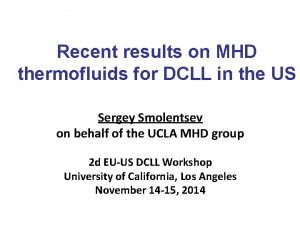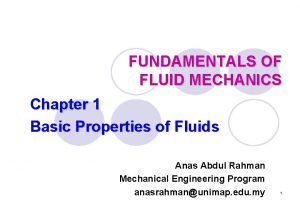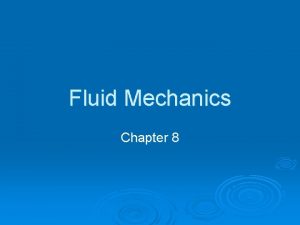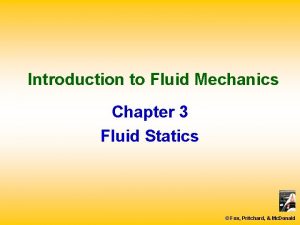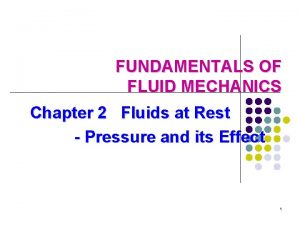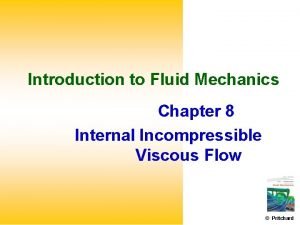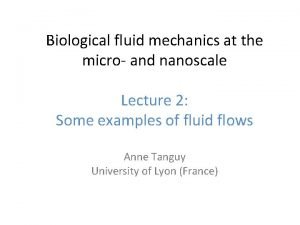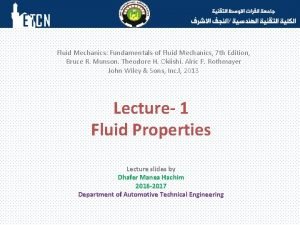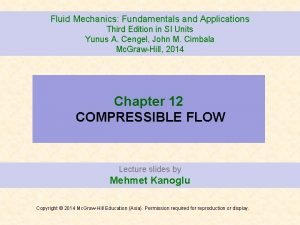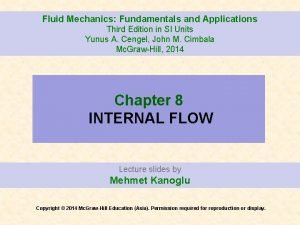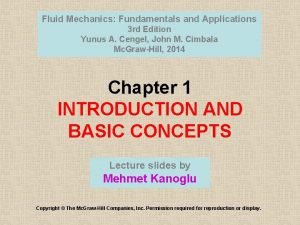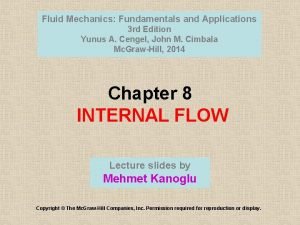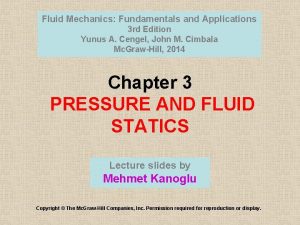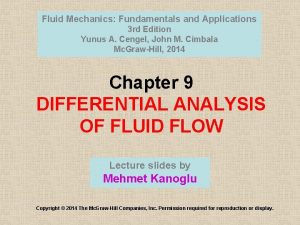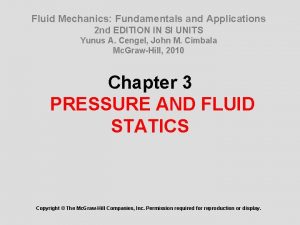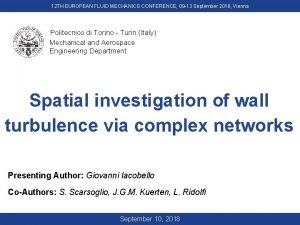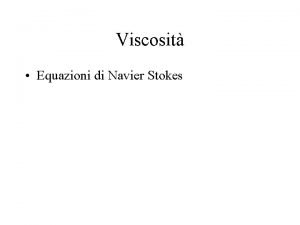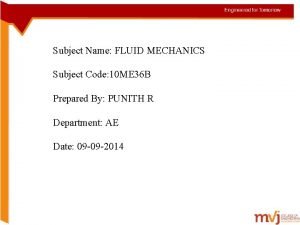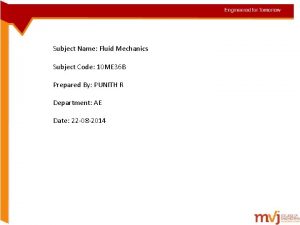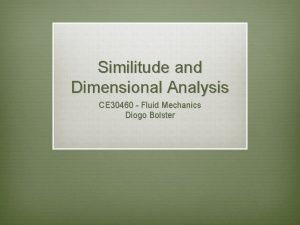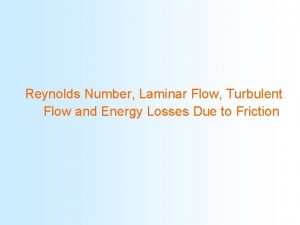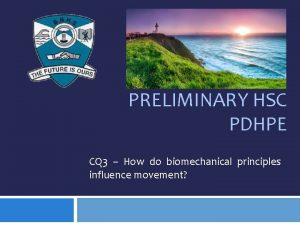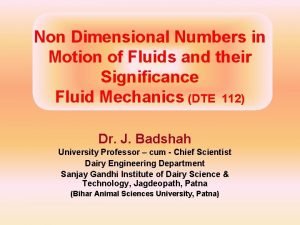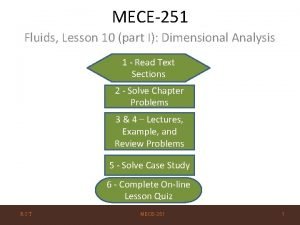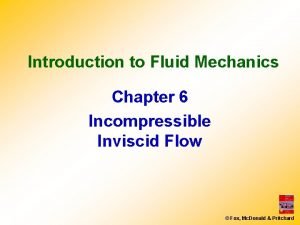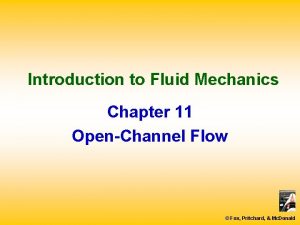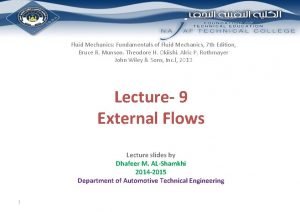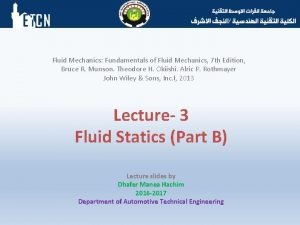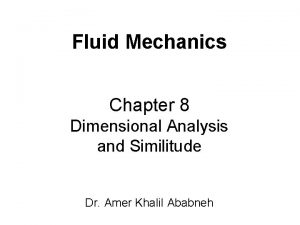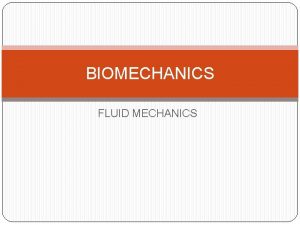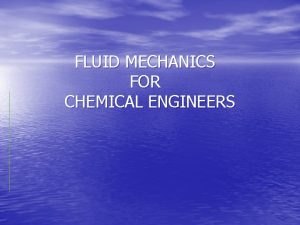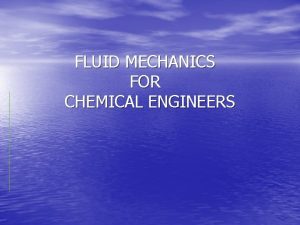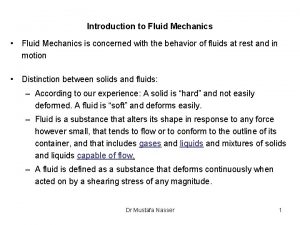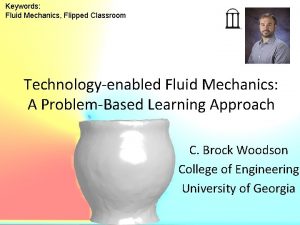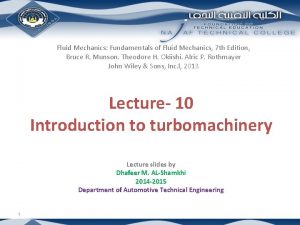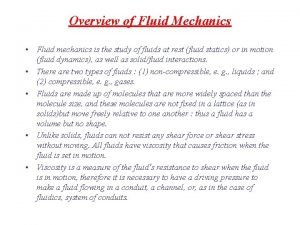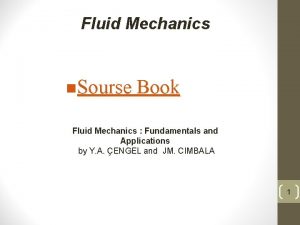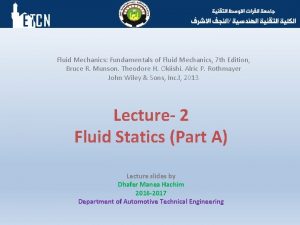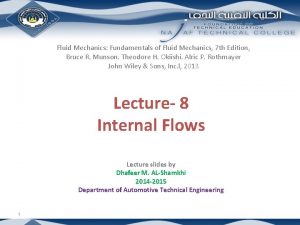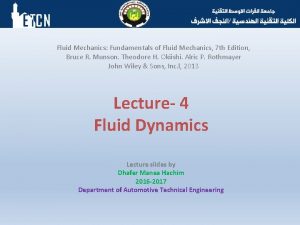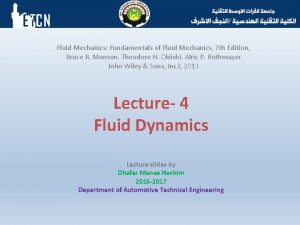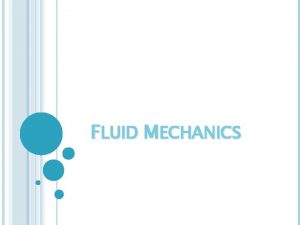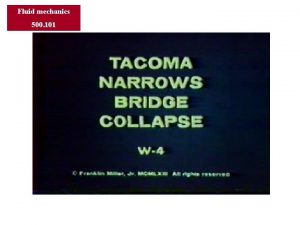Chapter 1 Introduction to Thermofluids And Fluid Mechanics






































- Slides: 38

Chapter 1 : Introduction to Thermofluids And Fluid Mechanics • Fluid properties such as density, shear stress, velocity and etc. Viscosity, and its correlation with human blood. tension and capillary effect, surface tension in biomedical engineering. Course Outcome • Ability to explain and analyze the fundamental principles of fluid mechanics. ENT 319 THERMOFLUIDS RK 85 BIOMEDICAL ELECTRONIC ENGINEERING 1

INTRODUCTION TO FLUID MECHANICS • Define and explain fluid properties such as density, shear stress, velocity and etc. • Define, explain and derive viscosity, and explain its correlation with human blood. Viscosity measurement. • Define and explain the surface tension and capillary effect. • Explain the effect of surface tension in biomedical engineering. Thermal-fluid sciences: The physical sciences that deal with energy and the transfer, transport, and conversion of energy. ENT 319 THERMOFLUIDS RK 85 2

APPLICATION AREAS OF THERMAL FLUID SCIENCE Designing Radiator: 1. Amount of energy transfer from a knowledge of the properties of coolant, thermodynamics. 2. Size of inner and outer fins, heat transfer. 3. Size and type of the water pump, fluid mechanics. 3

INTRODUCTION TO THERMAL FLUID SCIENCES Subcategories of • Fluid Mechanics • Thermodynamics • Heat Transfer ENT 319 THERMOFLUIDS RK 85 BIOMEDICAL ELECTRONIC ENGINEERING 4

THERMODYNAMICS • The science that studies energy and the transformation of energy into work, or moving things around. ENT 319 THERMOFLUIDS RK 85 BIOMEDICAL ELECTRONIC ENGINEERING 5

THERMODYNAMICS LAWS The First law • Conservation of energy principle (energy change from on state to another, cannot be destroyed). The Second law • Energy has quality and quantity, actual processes occur in the direction of decreasing quality of energy. The Zeroth law • Thermal Equilibrium (temperature measurement) ENT 319 THERMOFLUIDS RK 85 BIOMEDICAL ELECTRONIC ENGINEERING 6

HEAT TRANSFER • The science that deal with the determination of the rates of such energy transfers. Heat A form of energy that can be transferred from one system to another as a result of temperature difference. ENT 319 THERMOFLUIDS RK 85 BIOMEDICAL ELECTRONIC ENGINEERING 7

Comparison Between Thermodynamics and Heat Transfer Thermodynamics Heat Transfer Amount (how much) of heat transfer. “amount of heat from thermos when hot coffee cool down from 90 to 80 degrees” Rate (how long) of heat transfer Equilibrium state Non-equilibrium state “How long does it take for hot coffee to cool down from 90 to 80 degrees” ENT 319 THERMOFLUIDS RK 85 BIOMEDICAL ELECTRONIC ENGINEERING Next Lecture 8

Fluid Mechanics • The sciences that deals with the behavior of fluids at rest (fluids statics) or fluids in motion (fluid dynamics), and interaction of fluids with solids or other fluids at the boundaries. ENT 319 THERMOFLUIDS RK 85 BIOMEDICAL ELECTRONIC ENGINEERING 9

APPLICATION AREAS OF THERMAL FLUID SCIENCE • Pumping of blood to all parts of human body, Fluid Mechanics. • Energy conversion in cells, Thermodynamics. • Heat generated and rejected from bodies, adjusting clothes to the environment to control heat transfer, Heat Transfer. ENT 319 THERMOFLUIDS RK 85 BIOMEDICAL ELECTRONIC ENGINEERING 10

DIMENSIONAL HOMOGENEOUS • Every terms in an equation must have the same dimensions. • Spotting Errors in unit; E (k. J) = 25 k. J + 7 k. J/Kg Fundamental Dimension: M, L, T • Obtain formulas from unit; ρ = 850 kg/m 3; V = 2 m 3 ENT 319 THERMOFLUIDS RK 85 BIOMEDICAL ELECTRONIC ENGINEERING 11

FLUID MECHANICS - CATEGORIES • Also referred as Fluid Dynamics. • Incompressible (density constant, e. g. Water, gases at low speed), HYDRODYNAMICS. • Compressible (density change significantly) fluid flow, nozzles at high speed, GAS DYNAMICS. • AERODYNAMICS, flow of gases (especially air) over bodies, aircraft, automobiles. ENT 319 THERMOFLUIDS RK 85 BIOMEDICAL ELECTRONIC ENGINEERING 12

WHAT IS FLUID? Fluid • A substance in the gas or liquid phase. • A liquid takes the shape of the container, free surface under gravity. • Gases cannot form a free surface ENT 319 THERMOFLUIDS RK 85 BIOMEDICAL ELECTRONIC ENGINEERING 13

STRESS (FORCE/AREA) ON FLUID • The normal stress and shear stress at the surface of a fluid element. ENT 319 THERMOFLUIDS RK 85 BIOMEDICAL ELECTRONIC ENGINEERING 14

DISTINCTION BETWEEN SOLID AND FLUID Solid • Resist an applied shear stress by deforming. • Stress proportional to strain. Fluid • Deforms continuously under the influence of shear stress. • Stress proportional to strain rate. ENT 319 THERMOFLUIDS RK 85 BIOMEDICAL ELECTRONIC ENGINEERING 15

VISCOSITY • Density & specific weight measure heaviness • What is measured by viscosity? ü Easiness of fluid to flow. ü Internal resistance of fluid to motion. ENT 319 THERMOFLUIDS RK 85 BIOMEDICAL ELECTRONIC ENGINEERING 16

VISCOSITY U(h)=V y No slip condition B Oil between two plates F Moveable Plate B’ h dγ (small deformation) A Stationary Plate U(0)=0 Velocity gradient , d. U/dy = V/h Applied force Frictional force ENT 319 THERMOFLUIDS RK 85 BIOMEDICAL ELECTRONIC ENGINEERING 17

VISCOSITY (P. 424) • F = τA, τ = F/A, τ is shear stress • Based on the experimental analysis; ü F∝AV/h or F/A∝V/h ü A: Interface area between fluid and plate • Shear Stress acting on fluid layer is defined as, ü Finally, τ∝V/h ∝ du/dy ü τ = µ du/dy, µ is viscosity ü [Compare with F = µN] 18

THE ROTATING-DRUM VISCOMETER (P. 431) ENT 319 THERMOFLUIDS RK 85 BIOMEDICAL ELECTRONIC ENGINEERING 19

VISCOMETRY (P. 435) • How is viscosity measured? A rotating viscometer. üTwo concentric cylinders with a fluid in the small gap ℓ. üInner cylinder is rotating, outer one is fixed. ENT 319 THERMOFLUIDS RK 85 BIOMEDICAL ELECTRONIC ENGINEERING 20

MEASUREMENT OF VISCOSITY (P. 435) -----(1) ENT 319 THERMOFLUIDS RK 85 BIOMEDICAL ELECTRONIC ENGINEERING 21

VISCOSITY NEWTONIAN & NON NEWTONIAN (P. 431) Bingham Plastic – Toothpaste and Mayonnaise τ Shear thinning - Latex Newtonian - Oil, Water Shear thickening - quicksand dƔ/dt • Newtonian – constant viscosity • Non-Newtonian (apparent viscosity) ü Shear thinning – viscosity , shearing rate (velocity gradient) ü Shear thickening – viscosity , shearing rate (velocity gradient) • Bingham plastic – constant viscosity but at certain amount shear stress, fluid starts 22 shearing

BLOOD • Blood is a living tissue composed of blood cells suspended in plasma. • It consists of aqueous and cellular phase. • The cellular phase is about 45% of the blood. • It contains 95% red blood cells, 0. 13% white blood cells and 4. 9% platelets. ENT 319 THERMOFLUIDS RK 85 BIOMEDICAL ELECTRONIC ENGINEERING 23

BLOOD • The plasma (aqueous phase) is about 55% of the blood • It contains water 92%, miscellaneous elements and 7% protein – fibrinogen, globulin and albumin. ENT 319 THERMOFLUIDS RK 85 BIOMEDICAL ELECTRONIC ENGINEERING 24

BLOOD VISCOSITY • Blood non-Newtonian but could behave as Newtonian at higher shear rates (>100 1/s) ENT 319 THERMOFLUIDS RK 85 BIOMEDICAL ELECTRONIC ENGINEERING 25

FACTORS EFFECTING BLOOD VISCOSITY • The percentage of red blood cell in blood (Hematrocit). Higher Red Cell, Higher Viscosity. • A normal Hematrocit in human males is 42 to 45%. • The effect of temperature on the viscosity of bloods is still not clearly established. Temperature decrease, viscosity increase. • Implications: ü When a person's hand is cooled by exposure to a cold environment, the increase in blood viscosity contributes to the decrease in blood flow. 26

FACTOR EFFECTING BLOOD VISCOSITY • The apparent viscosity increases with the increase of tube diameter, Fahraeus-Lindqvist effect. • Larger Arteries ü RBCs have great random motion: some move horizontally, others vertically, and others with an angle. Thus, internal friction is great, which increases viscosity. • Smaller Arteries ü RBCs have no random motion: each RBC must move singly, one after the other. Thus, internal friction is minor, which decreases viscosity. 27

SURFACE TENSION (P. 436) 28

SURFACE TENSION • The cohesive forces between molecules down into a liquid are shared with all neighboring atoms and balance each other because of symmetry. • The attractive forces acting on the surface molecule are not symmetric, and the attractive forces applied by the gas molecules above are very small. It experiences forces only sideways and downward, which creates the surface tension effect. 29

LUNG PHYSIOLOGY AND PATHOLOGY Respiration System 30

Lung physiology and pathology (1/3) • Alveoli üGas exchange from lung to the blood or vice versa üSpherical in shape and are connected to terminal bronchi in lung üSize vary widely üWalls are covered with thin films of water. üSurface tension acts on the alveoli. ENT 319 THERMOFLUIDS RK 85 BIOMEDICAL ELECTRONIC ENGINEERING 31

Lung physiology and pathology (2/3) • SURFACE TENSION has tendency to collapsed the alveoli. Also, it would be difficult to re-expand the alveoli. • SURFACTANTS (lipoprotein-rich phospholipid) is secreted to prevent collapsed of alveoli (exhale) and avoid overdistension of alveoli (inhale) ENT 319 THERMOFLUIDS RK 85 BIOMEDICAL ELECTRONIC ENGINEERING 32

Lung physiology and pathology (3/3) • Fetuses produce surfactant in week 24 to 28. By week 35, fetuses have enough surfactant. • Danger to premature infant (before week 30), respiratory distress syndrome (hard to breath) due to lack of surfactant. • Labored breathing and incomplete expansion of the lungs. Synthetic surfactants. ENT 319 THERMOFLUIDS RK 85 BIOMEDICAL ELECTRONIC ENGINEERING 33

SURFACE TENSION • Table shows the surface tension of water. 34

CAPILLARY EFFECT OF SURFACE TENSION (P. 438) ü Capillary effect is the rise or fall of a liquid in a smalldiameter tube. ü The curved free surface in the tube is call the meniscus. ü Force balance can describe magnitude of capillary rise. For water-glass in atmospheric air, Ø = 0 35

CAPILLARY EFFECT • When the attractive forces are between unlike molecules, they are said to be adhesive forces. The adhesive forces between water molecules and the walls of a glass tube are stronger than the cohesive forces (attraction between like molecules) lead to an upward turning meniscus at the walls of the vessel and contribute to capillary action. ENT 319 THERMOFLUIDS RK 85 BIOMEDICAL ELECTRONIC ENGINEERING 36

SUMMARY • • • Definition of thermal fluid and its application Definition of subcategories of thermal-fluid science. Introduction to Fluid Mechanics. Viscosity and its relation to human blood. Surface tension and its relation to Biomedical field. ENT 319 THERMOFLUIDS RK 85 BIOMEDICAL ELECTRONIC ENGINEERING 37

REFERENCE 1. Biofluid Mechanics: The Human Circulation 2. Thermal-Fluid Sciences, Yunus A. Cengel, Robert H. Turner, John M. Cimbala 3. http: //en. wikibooks. org/wiki/Biomechanics/Hemodynamics 4. http: //www. vilastic. com/FAQ_Blood. htm ENT 319 THERMOFLUIDS RK 85 BIOMEDICAL ELECTRONIC ENGINEERING 38
 Thermofluids
Thermofluids Fluid kinematics
Fluid kinematics Dynamic viscosity symbol
Dynamic viscosity symbol Holt physics chapter 8 fluid mechanics test answers
Holt physics chapter 8 fluid mechanics test answers Fluid mechanics chapter 3
Fluid mechanics chapter 3 Gage pressure
Gage pressure Fluid mechanics chapter 8 solutions
Fluid mechanics chapter 8 solutions Total body water
Total body water Extracellular fluid and interstitial fluid
Extracellular fluid and interstitial fluid Fluid mechanics fundamentals and applications
Fluid mechanics fundamentals and applications Micro and nanoscale fluid mechanics
Micro and nanoscale fluid mechanics Capillary force
Capillary force Fanno flow
Fanno flow Hydrodynamic entry length formula
Hydrodynamic entry length formula Fluid mechanics fundamentals and applications
Fluid mechanics fundamentals and applications Fluid mechanics fundamentals and applications
Fluid mechanics fundamentals and applications Fluid mechanics fundamentals and applications
Fluid mechanics fundamentals and applications Viscous fluid example
Viscous fluid example Fluid mechanics fundamentals and applications
Fluid mechanics fundamentals and applications European fluid mechanics and turbulence conference
European fluid mechanics and turbulence conference Is synovial fluid extracellular fluid
Is synovial fluid extracellular fluid Fluid statics deals with fluid at rest
Fluid statics deals with fluid at rest Fluid statics deals with fluid at rest
Fluid statics deals with fluid at rest Ecf icf and interstitial fluid
Ecf icf and interstitial fluid Hypoosmotic
Hypoosmotic Fluid thrill ascites volume
Fluid thrill ascites volume Equazioni navier stokes
Equazioni navier stokes Loss of head due to sudden contraction of pipe *
Loss of head due to sudden contraction of pipe * Limitations of bernoulli's theorem
Limitations of bernoulli's theorem Dimensionless groups in fluid mechanics
Dimensionless groups in fluid mechanics Reynolds number turbulent flow
Reynolds number turbulent flow Fluid mechanics pdhpe
Fluid mechanics pdhpe Non dimensional numbers
Non dimensional numbers Dimensionless groups in fluid mechanics
Dimensionless groups in fluid mechanics Incompressible inviscid flow
Incompressible inviscid flow Critical flow examples
Critical flow examples Critical reynolds number
Critical reynolds number Hydrostatic force on a vertical wall formula
Hydrostatic force on a vertical wall formula Similitude fluid mechanics
Similitude fluid mechanics
